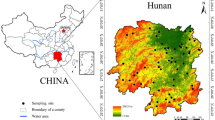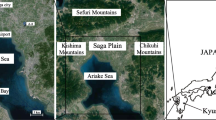Abstract
Chemical denudation and chemical weathering rates vary under climatic, bedrock, biotic, and topographic conditions. Constraints for landscape evolution models must consider changes in these factors on human and geologic time scales. Changes in nutrient dynamics, related to the storage and exchange of K+ in clay minerals as a response to land use change, can affect the rates of chemical weathering and denudation. Incorporation of these changes in landscape evolution models can add insight into how land use changes affect soil thickness and erodibility. In order to assess changes in soil clay mineralogy that result from land-use differences, the present study contrasts the clay mineral assemblages in three proximal sites that were managed differently over nearly the past two centuries where contemporary vegetation was dominated by old hardwood forest, old-field pine, and cultivated biomes. X-ray diffraction (XRD) of the oriented clay fraction using K-, Mg-, and Na-saturation treatments for the air-dried, ethylene glycol (Mg-EG and K-EG) solvated, and heated (100, 350, and 550°C) states were used to characterize the clay mineral assemblages. XRD patterns of degraded biotite (oxidized Fe and expelled charge-compensating interlayer K) exhibited coherent scattering characteristics similar to illite. XRD patterns of the Mg-EG samples were, therefore, accurately modeled using NEWMOD2® software by the use of mineral structure files for discrete illite, vermiculite, kaolinite, mixed-layer kaolinite-smectite, illite-vermiculite, kaolinite-illite, and hydroxy-interlayered vermiculite. The soil and upper saprolite profiles that formed on a Neoproterozoic gneiss in the Calhoun Experimental Forest in South Carolina, USA, revealed a depth-dependence for the deeply weathered kaolinitic to the shallowly weathered illitic/vermiculitic mineral assemblages that varied in the cultivated, pine, and hardwood sites, respectively. An analysis of archived samples that were collected over a five-decade growth period from the pine site suggests that the content of illite-like layers increased at the surface within 8 y. Historical management of the sites has resulted in different states of dynamic equilibrium, whereby deep rooting at the hardwood and pine sites promotes nutrient uplift of K from the weathering of orthoclase and micas. Differences in the denudation rates at the cultivated, pine, and hardwood sites through time were reflected by changes in the soil clay mineralogy. Specifically, an increased abundance of illite-like layers in the surface soils can serve as a reservoir of K+.
Similar content being viewed by others
References
Bacon, A.R. (2014) Pedogenesis and Anthropedogenesis on the Southern Piedmont. Doctor of Philosophy PhD thesis. Duke University, Durham, NC. Bacon_duke_0066D_12361.pdf.
Balogh-Brunstad, Z., Keller, C.K., Bormann, B.T., O’Brien, R., Wang, D., and Hawley, G. (2008) Chemical weathering and chemical denudation dynamics through ecosystem development and disturbance. Global Biogeochemical Cycles, 22, https://doi.org/10.1029/2007GB0022957.
Barre, P., Montagnier, C., Chenu, C., Abbadie, L., and Velde, B. (2008a) Clay minerals as a soil potassium reservoir: Observation and quantification through X-ray diffraction. Plant and Soil, 302, 213–220.
Barre, P., Velde, B., and Abbadie, L. (2007a) Dynamic role of “illite-like” clay minerals in temperate soils: Facts and hypotheses. Biogeochemistry, 82, 77–88.
Barre, P., Velde, B., Catel, N., and Abbadie, L. (2007b) Soilplant potassium transfer: Impact of plant activity on clay minerals as seen from X-ray diffraction. Plant and Soil, 292, 37–146.
Barre, P., Velde, B., Fontaine, C., Catel, N., and Abbadie, L. (2008b) Which 2:1 clay minerals are involved in the soil potassium reservoir? Insights from potassium addition or removal experiments on three temperate grassland soil clay assemblages. Geoderma, 146, 216–223.
Calvaruso, C., Mareschal, L., Turpault, M.P., and Leclerc, E. (2009) Rapid clay weathering in the rhizosphere of Norway spruce and oak in an acid forest ecosystem. Soil Science Society of America Journal, 73, 331–338.
Chartier, M.P., Rostagno, C.M., and Videla, L.S. (2013) Selective erosion of clay, organic carbon and total nitrogen in grazed semiarid rangelands of northeastern Patagonia, Argentina. Journal of Arid Environments, 88, 43–49.
Cook, C.W., Brecheisen, Z., and Richter, D. (2015) Calhoun CZO - Vegetation - Tree Survey (2014–2017). https://doi.org/criticalzone.org/calhoun/data/dataset/4614/.
Cornu, S., Montagne, D., Hubert, F., Barre, P., and Caner, L. (2012) Evidence of short-term clay evolution in soils under human impact. Comptes Rendus Geoscience, 344, 747–757.
Di Stefano, C. and Ferro, V. (2002) Linking clay enrichment and sediment delivery processes. Biosystems Engineering, 81, 465–479.
Hack, J.T. (1960) Interpretation of erosional topography in humid temperate regions. American Journal of Science, 258, 80–97.
Hinsinger, P., Jaillard, B., and Dufey, J.E. (1992) Rapid weathering of a trioctahedral mica by the roots of ryegrass. Soil Science Society of America Journal, 56, 977–982.
Hong, H., Cheng, F., Yin, K., Churchman, G.J., and Wang, C. (2015) Three-component mixed-layer illite/smectite/kaolinite (I/S/K) minerals in hydromorphic soils, South China. American Mineralogist, 100, 1883–1891.
Hong, H., Churchman, G.J., Gu, Y., Yin, K., and Wang, C. (2012) Kaolinite-smectite mixed-layer clays in the Jiujiang red soils and their climate significance. Geoderma, 173, 75–83.
Horton, J.W. and Dicken, C.L. (2001) Preliminary Digital Geologic Map of the Appalachian Piedmont and Blue Ridge, South Carolina Segment. U. S. Geological Survey. https://doi.org/geo-nsdi-er.usgs/gov/metadat/open-file/01-298/.
Hubert, F., Caner, L., Meunier, A., and Ferrage, E. (2012) Unraveling complex <2 mm clay mineralogy from soils using X-ray diffraction profile modeling on particle-size sub-fractions: Implications for soil pedogenesis and reactivity. American Mineralogist, 97, 384–398.
Hubert, F., Caner, L., Meunier, A., and Lanson, B. (2009) Advances in characterization of soil clay mineralogy using X-ray diffraction: From decomposition to profile fitting. European Journal of Soil Science, 60, 1093–1105.
Jobbagy, E.G. and Jackson, R.B. (2004) The uplift of soil nutrients by plants: Biogeochemical consequences across scales. Ecology, 85, 2380–2389
Kingery, W.L., Han, F.X., Shaw, D.R., Gerard, P.D., and McGregor, K.C. (2002) Mineralogical and organic carbon content of water-dispersible particles from conventional and no-tillage soils. Communications in Soil Science and Plant Analysis, 33, 947–961.
Lanson, B. (1997) Decomposition of experimental X-ray diffraction patterns (profile fitting): A convenient way to study clay minerals. Clays and Clay Minerals, 45, 132–146.
Markewitz, D. and Richter, D.D. (2000) Long-term soil potassium availability from a Kanhapludult to an aggraging Loblolly pine ecosystem. Forest Ecology and Management, 130, 109–129.
Matocha, C.J., Grove, J.H., Karathanasis, T.D., and Vandiviere, M. (2016) Changes in soil mineralogy due to nitrogen fertilization in an agroecosystem. Geoderma, 263, 176–184
Metz, L.J. (1958) The Calhoun Experimental Forest. Pp. 24. in: Miscellaneous Publication, USDA U.S. Forest Service, Southern Research Station, Ashville, North Carolina, U.S.A.
Moore, D.M. and Reynolds, R.C., Jr. (1997) X-ray Diffraction and the Identification and Analysis of Clay Minerals. 2nd Edition. Pp. 378. Oxford University Press, New York.
NCALM. National Center for Airborne Laser Mapping (2016) Leaf-off LiDAR Survey of the Calhoun Critical Zone Observatory. https://doi.org/opentopo.sdsc.edu/datasetMetadata?otCollectionID=OT.072016.26917.2.
Officer, S.J., Tillman, R.W., Palmer, A.S., and Whitton, J.S. (2006) Variability of clay mineralogy in two New Zealand steep-land topsoils under pasture. Geoderma, 132, 427–440.
Palis, R.G., Ghandiri, H., Rose, C.W., and Saffigna, P.G. (1997) Soil erosion and nutrient loss. III. Changes in the enrichment ratio of total nitrogen and organic carbon under rainfall detachment and entrainment. Australian Journal of Soil Research, 35, 891–905.
Pernes-Debuyser, A., Pernes, M., Velde, B., and Tessier, D. (2003) Soil mineralogy evolution in the INRA 42 Plots Experiment (Versailles, France). Clays and Clay Minerals, 51, 577–584.
Richter, D.D. and Markewitz, D. (1995) How deep is soil? BioScience, 45, 600–609.
Richter, D.D. and Markewitz, D. (2001) Understanding Soil Change: Soil Sustainability Over Millennia, Centuries, and Decades. Pp. 255. Cambridge University Press, Cambridge and New York.
Tice, K.R., Graham, R.C., and Wood, H.B. (1996) Transformations of 2:1 phyllosilicates in 41-year-old soils under oak and pine. Geoderma, 70, 49–62.
Toby, B.H. (2006) R factors in Rietveld analysis: How good is good enough? Powder Diffraction, 21, 67–70.
Tributh, H., Vonboguslawski, E., Vonlieres, A., Steffens, D., and Mengel, K. (1987) Effect of potassium removal by crops on transformation of illitic clay-minerals. Soil Science, 143, 404–409.
Turpault, M.P., Righi, D., and Uterano, C. (2008) Clay minerals: Precise markers of the spatial and temporal variability of the biogeochemical soil environment. Geoderma, 147, 108–115.
Tye, A.M., Kemp, S.J., and Poulton, P.R. (2009) Responses of soil clay mineralogy in the Rothamsted classical experiments in relation to management practice and changing land use. Geoderma, 153, 136–146.
Velde, B. and Peck, T. (2002) Clay mineral changes in the Morrow Experimental Plots, University of Illinois. Clays and Clay Minerals, 50, 364–370.
Viennet, J.C., Hubert, F., Ferrage, E., Tertre, E., Legout, A., and Turpault, M.P. (2015) Investigation of clay mineralogy in a temperate acidic soil of a forest using X-ray diffraction profile modeling: Beyond the HIS and HIV description. Geoderma, 241, 75–86.
Yuan, H. and Bish, D.L. (2010) Newmod plus, a new version of the Newmod program for interpreting X-ray powder diffraction patterns from interstratified clay minerals. Clays and Clay Minerals, 58, 318–326.
Author information
Authors and Affiliations
Corresponding author
Rights and permissions
About this article
Cite this article
Austin, J.C., Perry, A., Richter, D.D. et al. Modifications of 2:1 Clay Minerals in a Kaolinite-Dominated Ultisol under Changing Land-Use Regimes. Clays Clay Miner. 66, 61–73 (2018). https://doi.org/10.1346/CCMN.2017.064085
Received:
Revised:
Published:
Issue Date:
DOI: https://doi.org/10.1346/CCMN.2017.064085




